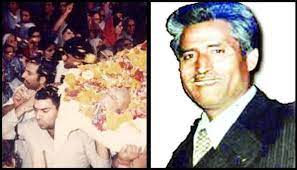
By Arun Anand
Every year September 14 is remembered as ‘Martyrdom Day’ by Kashmiri Hindus and organisations which support their cause who had to flee the valley in face of terrorism in 1990.
In fact, a motion was submitted in UK Parliament(https://edm.

On September 14, 1989, the first major killing of a Kashmiri Hindu leader Pt. Tika Lal Taploo happened in the valley setting the tone for the massive exodus of Kashmiri Hindus from Kashmir on 19 January, 1990. Pandit Taploo’s killing at the hand of terrorists was a turning point in the conflict in this region as he was the most prominent Kashmiri Hindu leader in the valley. His killing was the beginning of spree of terrorist attacks on Kashmiri Hindu leaders. Pandit Taploo’s assassination, was arguably the biggest blow to the moral of Kashmiri Hindus who had dug their heel to stay back in the valley.
It appears that he was chosen as a target strategically to start a mayhem that culminated into the exodus of Kashmiri Hindus.
Pandit Taploo passed his Matriculation in 1945 from Punjab University. He did his Masters in Arts (MA) and .L.L.B from Aligarh Muslim University and joined Kashmir Bar in 1957. Initially he was denied admission there along with some other Kashmiri Hindus. He started an agitation was staged dharna in the University campus. The protests compelled the AMU administration to yield the ground and give admission to all of them.
Taploo was also associated with Rashtriya Swayamsevak Sangh. He was enrolled as an Advocate of High Court in 1971. Taploo was married to Sarla in 1957 who was a government school teacher.
When Prime Minister Indira Gandhi imposed emergency during 1975, he courted arrest at Lal Chowk in Srinagar and led the agitation against emergency in the valley from the front.
He had a huge following amongst both Muslims and Hindus. He was popularly addressed ‘Lala’( ‘elder brother’ in Pashto) by the common people for his helpful attitude cutting across religious lines. He was known for his extensive social work activities and spartan life style.
His popularity amongst Muslims was proving to be one of the major challenges for the terrorists in Kashmir who were trying to communalise the atmosphere in 1980s.
After he received many threats from the terrorists, Taploo took his family to Delhi but he himself came back to challenge the terrorists. Four days after he had returned from Delhi, he was attacked at his residence Chinkral Mohalla. He publicly challenged the terrorists to dare to attack him again. On 14 September, in broad day light he was shot dead by the terrorists.
His funeral was attended by thousands of people including senior Bharatiya Janata Party leaders LK Advani and Kedarnath Sahani. Taploo was also the vice-president of the Jammu-Kashmir unit of the BJP. Muslims of the valley, also attended his funeral in large numbers. His assassination was a brutal blow to the resolve of Kashmiri Hindus and it sent shock waves among the community. They expressed their anguish by shutting down all the shops and business establishments for a day as a mark of protest. This was probably the first last time that Kashmiri Hindus had observed a ‘bandh’ in valley against the spate of killings that began soon.
After Taploo’s death, Srinagar District Sessions Judge Nilkanth Ganjoo was shot dead. He had sentenced Maqbul Bhat, a terrorist and founder of the separatist organisation National Liberation Front. Maqbul Bhat was hanged on 11 February 1984 in Tihar Jail in New Delhi.
In 1989, the then chief minister of J&K, Farooq Abdullah, had ordered the release of around 70 terrorists between July and December 1989. They had been trained in terrorist camps in Pakistan-occupied J&K.
The top four among them were Hamid Sheikh, Ashfaq Wani, Javed Mir and Yasin Malik. They played a major role in promoting insurgency and creating an anti-Hindu atmosphere in the Valley.
By the end of 1989, the demand to establish the Islamic dominion in the Kashmir Valley and separate it from India had hit the peak. On the evening of 19 January 1990, pro-Pakistan sloganeering started from the mosques in the Valley and mobs started gathering. Posters came up, asking Hindus to either convert to Islam and join the separatists or leave their homes.
Thousands of Hindus left through the night. According to a report by Jammu-Kashmir Study Centre, a Delhi-based think tank, by March 1990, more than 90 per cent of the Hindus residing in the Valley had left their homes. Meanwhile, most of the Hindu’s houses were burnt down in the Valley and whatever was left of their movable properties was looted. However, the precursor to all these developments was the killing of Pandit Taploo on 14 September, 1989.
(Views expressed are personal)